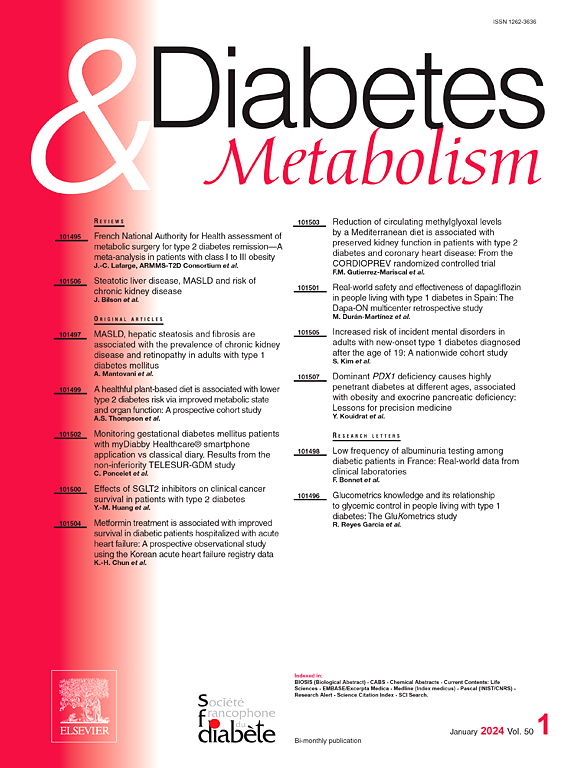Methylamine metabolites and progression to kidney failure in type 2 diabetes: An Asian and European prospective study
IF 4.7
2区 医学
Q1 ENDOCRINOLOGY & METABOLISM
引用次数: 0
Abstract
Aim
Unlike trimethylamine N-oxide (TMAO), the role of methylamine pathway metabolites in diabetic kidney disease (DKD) remains unclear. We investigated the association of circulating methylamines with progression of DKD in a prospective cohort study of patients with type 2 diabetes of two different ethnic backgrounds.
Methods
We analyzed two independent cohorts: a European-origin cohort (SURDIAGENE France; n = 1,357) and an Asian-origin cohort (Khoo Teck Puat Hospital-DKD [KTPH-DKD] Singapore, n = 1,868). The primary composite renal outcome in SURDIAGENE was sustained doubling of serum creatinine or kidney failure with replacement therapy (KFRT), while the secondary outcome was 40% renal function loss (RFL40). In KTPH-DKD, KFRT was the primary outcome. Baseline betaine, carnitine, choline, trimethylamine and TMAO concentrations were measured in plasma by mass-spectrometry. Cox regression models were used to estimate the risk of DKD progression, adjusting for demographics, clinical parameters, and comorbidities.
Results
Over a median follow-up of 7.1 years (IQR 4.5-10.7), we registered 75 composite renal outcomes in SURDIAGENE and over 10.7 years (IQR 7.0-11.8), 149 KFRT in KTPH-DKD. Choline was the only consistently associated with progression of DKD in both cohorts: HR [95%CI] per 1 SD = 1.29 [1.02;1.62], P = 0.033 for composite renal outcome, 1.11 [1.01;1.23], P = 0.028 for RFL40 in SURDIAGENE, and 1.84 [1.30;2.61], P < 0.001 for KFRT in KTPH-DKD.
Conclusion
Plasma choline is an independent risk factor for DKD progression in two independent type 2 diabetes populations. Interventional trials are needed to assess whether reducing dietary choline intake could mitigate severe renal outcomes in type 2 diabetes.
甲胺代谢物与2型糖尿病肾衰竭进展:一项亚洲和欧洲的前瞻性研究
目的:与三甲胺n -氧化物(TMAO)不同,甲胺途径代谢物在糖尿病肾病(DKD)中的作用尚不清楚。我们在一项针对两种不同种族背景的2型糖尿病患者的前瞻性队列研究中调查了循环甲胺与DKD进展的关系。方法:我们分析了两个独立的队列:一个是欧洲裔队列(SURDIAGENE France;n= 1357)和一个亚裔队列(新加坡Khoo Teck Puat Hospital-DKD [KTPH-DKD], n= 1868)。SURDIAGENE的主要综合肾脏结局是替代治疗(KFRT)时血清肌酐持续翻倍或肾功能衰竭,而次要结局是40%肾功能丧失(RFL40)。在KTPH-DKD中,KFRT是主要转归。用质谱法测定血浆中甜菜碱、肉碱、胆碱、三甲胺和氧化三甲胺的基线浓度。Cox回归模型用于估计DKD进展的风险,并根据人口统计学、临床参数和合并症进行调整。结果:在中位随访7.1年(IQR 4.5-10.7)中,SURDIAGENE组记录了75例复合肾脏结局,在10.7年(IQR 7.0-11.8)中,KTPH-DKD组记录了149例KFRT。在两个队列中,胆碱是唯一与DKD进展一致的相关因素:每1 SD的HR [95%CI] = 1.29[1.02;1.62],复合肾结局的P = 0.033,1.11 [1.01;1.23],SURDIAGENE组RFL40的P = 0.028,KTPH-DKD组KFRT的P = 0.028,KTPH-DKD组KFRT的P = 1.84 [1.30;2.61],P < 0.001。结论:血浆胆碱是两个独立2型糖尿病人群中DKD进展的独立危险因素。需要进行干预性试验来评估减少饮食胆碱摄入量是否可以减轻2型糖尿病患者严重的肾脏结局。
本文章由计算机程序翻译,如有差异,请以英文原文为准。
求助全文
约1分钟内获得全文
求助全文
来源期刊

Diabetes & metabolism
医学-内分泌学与代谢
CiteScore
12.00
自引率
4.20%
发文量
86
审稿时长
13 days
期刊介绍:
A high quality scientific journal with an international readership
Official publication of the SFD, Diabetes & Metabolism, publishes high-quality papers by leading teams, forming a close link between hospital and research units. Diabetes & Metabolism is published in English language and is indexed in all major databases with its impact factor constantly progressing.
Diabetes & Metabolism contains original articles, short reports and comprehensive reviews.
 求助内容:
求助内容: 应助结果提醒方式:
应助结果提醒方式:


